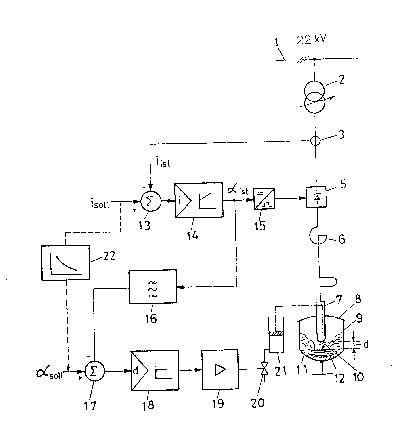Une partie des informations de ce site Web a été fournie par des sources externes. Le gouvernement du Canada n'assume aucune responsabilité concernant la précision, l'actualité ou la fiabilité des informations fournies par les sources externes. Les utilisateurs qui désirent employer cette information devraient consulter directement la source des informations. Le contenu fourni par les sources externes n'est pas assujetti aux exigences sur les langues officielles, la protection des renseignements personnels et l'accessibilité.
L'apparition de différences dans le texte et l'image des Revendications et de l'Abrégé dépend du moment auquel le document est publié. Les textes des Revendications et de l'Abrégé sont affichés :
| (12) Demande de brevet: | (11) CA 2060006 |
|---|---|
| (54) Titre français: | PROCEDE ET DISPOSITIF DE COMMANDE DES ELECTRODES POUR FOUR A ARC A COURANT CONTINU |
| (54) Titre anglais: | PROCESS FOR ELECTRODE CONTROL OF A DC ARC FURNACE, AND AN ELECTRODE CONTROL DEVICE |
| Statut: | Réputée abandonnée et au-delà du délai pour le rétablissement - en attente de la réponse à l’avis de communication rejetée |
| (51) Classification internationale des brevets (CIB): |
|
|---|---|
| (72) Inventeurs : |
|
| (73) Titulaires : |
|
| (71) Demandeurs : |
|
| (74) Agent: | SWABEY OGILVY RENAULT |
| (74) Co-agent: | |
| (45) Délivré: | |
| (22) Date de dépôt: | 1992-01-24 |
| (41) Mise à la disponibilité du public: | 1992-08-09 |
| Licence disponible: | S.O. |
| Cédé au domaine public: | S.O. |
| (25) Langue des documents déposés: | Anglais |
| Traité de coopération en matière de brevets (PCT): | Non |
|---|
| (30) Données de priorité de la demande: | ||||||
|---|---|---|---|---|---|---|
|
ABSTRACT OF THE DISCLOSURE
DC arc furnaces (8) have a current controller
(14) for stabilizing the current of an arc (10), and an
electrode controller (18) for influencing the position
of an electrode (7) of the arc furnace (8) and thus the
length of an arc (10). The control of the position of
the electrode (7) is performed by means of a hydraulic
electrode adjusting device (21), which is controlled as
a function of a difference between a prescribable
electrode controller reference variable signal (.alpha.des)
and a rectifier manipulated variable signal (.alpha.act) at
the output of the current controller (14). As a result,
the arc length is regulated such that a rectifier (5)
operates on average with a drive level of, for example,
25° electrical, irrespective of the secondary voltage
of a furnace transformer (2) and of an adjusted desired
current value signal (ides). Limiting values are
monitored and undesired frequencies are filtered out by
means of a bandpass filter (16) between the output of
the current controller (14) and a comparator or summer
(17) for forming the difference signal between the
electrode controller reference variable signal (.alpha.des)
and the rectifier manipulative variable signal (.alpha.act).
Note : Les revendications sont présentées dans la langue officielle dans laquelle elles ont été soumises.
Note : Les descriptions sont présentées dans la langue officielle dans laquelle elles ont été soumises.

2024-08-01 : Dans le cadre de la transition vers les Brevets de nouvelle génération (BNG), la base de données sur les brevets canadiens (BDBC) contient désormais un Historique d'événement plus détaillé, qui reproduit le Journal des événements de notre nouvelle solution interne.
Veuillez noter que les événements débutant par « Inactive : » se réfèrent à des événements qui ne sont plus utilisés dans notre nouvelle solution interne.
Pour une meilleure compréhension de l'état de la demande ou brevet qui figure sur cette page, la rubrique Mise en garde , et les descriptions de Brevet , Historique d'événement , Taxes périodiques et Historique des paiements devraient être consultées.
| Description | Date |
|---|---|
| Inactive : CIB de MCD | 2006-03-11 |
| Inactive : CIB de MCD | 2006-03-11 |
| Le délai pour l'annulation est expiré | 1996-07-24 |
| Demande non rétablie avant l'échéance | 1996-07-24 |
| Réputée abandonnée - omission de répondre à un avis sur les taxes pour le maintien en état | 1996-01-24 |
| Inactive : Demande ad hoc documentée | 1996-01-24 |
| Demande publiée (accessible au public) | 1992-08-09 |
| Date d'abandonnement | Raison | Date de rétablissement |
|---|---|---|
| 1996-01-24 |
Les titulaires actuels et antérieures au dossier sont affichés en ordre alphabétique.
| Titulaires actuels au dossier |
|---|
| ASEA BROWN BOVERI LTD. |
| Titulaires antérieures au dossier |
|---|
| EDUARD STREBEL |